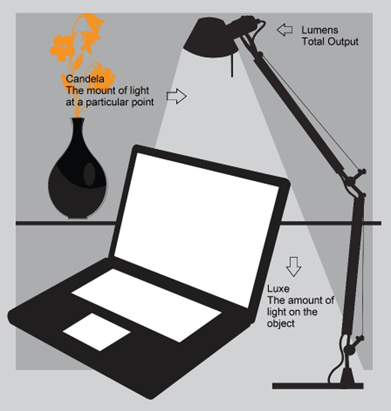LED Lighting Terms Explained
With so many different types of LED lighting on the market, all with different features and benefits, it can be quite hard to know exactly what you are paying for and exactly what you’re getting for your money. Below you will find a glossary of terms that are used within the lighting industry so that you are able to better decide on which product is better for you.
Glossary of Terms
AC
This is Alternating Current. This is the electricity that is used in most domestic and commercial spaces. It’s often referred to as mains voltage and number differs from country to country. UK mains voltage is typically 220-240V.
Candela
The candela is used to measure the visual intensity of light sources at a certain point.

CCT – Correlated Colour Temperature
CCT measures how white a LED light source is. A Value of 2700K gives a warm white like a sunset, whilst a value of 6000K or above a cooler white. The CCT is measured in degrees Kelvin.

CELMA
CELMA is the Federation of National Manufacturers Associations for Luminaires and Electrotechnical components in the European Union. CELMA provide standards and guides for LED lighting in Europe.
Circadian Rhythm
Circadian rhythms are 24-hour cycles that are part of the body’s internal clock. Circadian LED lights match this natural 24-hour cycle by changing there CCT value depending on the time of day. Research has shown these lights help regulate your sleep-wake cycle by controlling the body’s melatonin (sleep hormone) production.

COB
Manufacturers often quote their products as having COB. COB stands for Chip-on-board and refers to the mounting of a bare LED chip in direct contact with a substrate to produce LED arrays. Older Technologies such as “DIP” Dual inline package or SMD” Surface mounted device, have a lower density of LED’s and produce a poorer uniformity level of light.
CRI – Colour Rendering Index
The colour rendering index (CRI) is a measure of the ability of a light source to reveal how closely it can reproduce itself to the standard light source. A Light source with a high CRI is ideal in applications where desirable in colour-critical applications are required such as Retail and Electronic Assembly.
A Light with a CRI rating of 100 gives a perfect match to natural day light. Most modern LED’s have a rating of 80 CRI or higher.
DC
This is Direct Current, most LED units on the market use low-voltage DC. A Driver or low-voltage battery is often required to step-down the AC mains voltage to a suitable level for the LED which is normally 3V or 6V DC.
Driver
A LED is a low voltage device so a Driver is needed to convert Mains Voltage down to its working level. Some Drivers also allow the dimming of the light source.
Goniophotometer
A goniophotometer is a device that measures the mount of light an item disperses at a different angle. They measure the luminous flux or luminous intensity distribution of a light source.
IP Rating – Ingress Protection
This is an International Standard that that defines the ability of a product to be able to work in different environments. IP stands for “Ingress Protection”, it is a measurement of the protection an item will have against solid objects (dust, sand, dirt, etc.) and liquids.
The first digit gives the amount of protection against Solids, and ranges from 0 to 6, where 0 is no protection and 6 is the highest. The second against digit defined the level of protection against liquids, where 0 is no protection and 9 is the highest, for example:
IP65 – Water resistant. “Protected against water jets from any angle”
IP67 – Water resistant plus. “Protected against the events of temporary submersion (10 minutes)
IP68 – Waterproof “Protected against the events of permanent submersion up to 3 meters”
If you’d like to find out more about this, read our article on IP Ratings.
LED Pitch
This is Direct Current, most LED units on the market use low-voltage DC. A Driver or low-voltage battery is often required to step-down the AC mains voltage to a suitable level for the LED which is normally 3V or 6V DC.
Lumens
Lumens is the measurement of luminous flux or how much light an item produces and is written as lm. A typical household incandescent 100W bulb gives out an output of 1,600lm.
Lumen Depreciation
Unlike conventional light sources LED lights don’t suddenly fail, there output reduces over time. This reduction in output is a lights Lumen Depreciation Value and is measured as a percentage of its original output. Once a lights Lumens output has reduced by 30% of its original output this is deemed to be the end of its life. This is often referred to as the L70 life and is measure in hours.
Luminous Efficiency (Lumens per Watt)
This is a measure of how much total effective light in all directions (Lumens) is produced per Watt of electrical power consumed.
MacAdam
The Macadam value of a light source is its range of colour. Colour deviations are specified in the MacAdam ellipses SDCM (Standard Deviation of Colour Matching) according to the CIE 1964 standard. Lighting with a value less than 3, are harder to detect with the naked eye, those with a value of 3 are best used inside use and those with a value more than 5 best used outside.
Relux
Relux is an industry standard piece of software that allows Lighting Engineers to produce lighting designs for clients.
SDCM – Standard Deviation Colour Matching
A SDCM value for a LED light source is its colour variation level where the human eye cannot perceive the colour difference. The SDCM value of a light source is the same as its Macadam Ellipse Value.
SSL – Solid State Lighting
LED lighting systems which use a semiconductor rather than an filament are referred to as Solid State Lighting.








